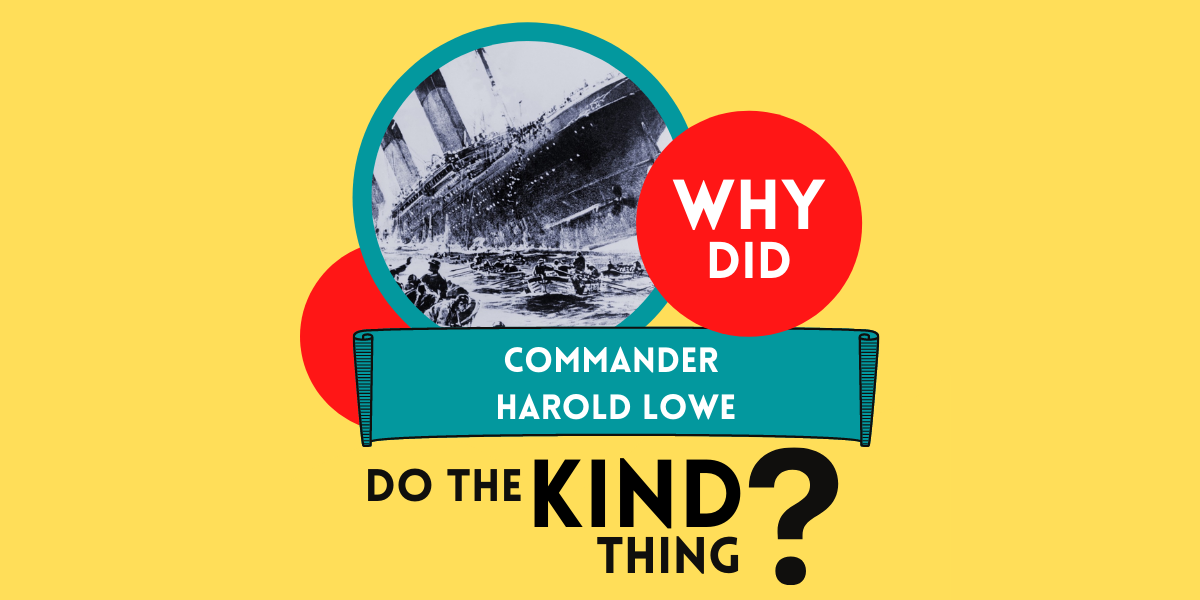Commander Harold Godfrey Lowe was born in Llanrhos, Caernarvonshire, Wales on 21 November 1882, the fourth of eight children, born to George and Harriet Lowe. His father had ambitions for him to be apprenticed to a successful Liverpool businessman, but Harold Lowe was determined to go to sea. At 14, he ran away from his home in Barmouth where he had attended school and joined the Merchant Navy, serving along the West African Coast. Lowe started as a Ship’s Boy aboard the Welsh coastal schooners as he worked to attain his certifications. In 1906, he passed his certification and gained his second mate’s certificate, then in 1908, he attained his first mate’s certificate. By the time he started with the White Star Line, in 1911, he had gained his Masters certificate and, in his own words, “experience with pretty well every ship afloat – the different classes of ships afloat – from the schooner to the square-rigged sailing vessel, and from that to steamships, and of all sizes.” He served as third officer on White Star’s ships: The Belgic and The Tropic before being transferred to Titanic as Fifth Officer in 1912. Despite his numerous years at sea, however, the maiden voyage of the Titanic was to be his first transatlantic crossing.
Aboard the Titanic – Lowe’s duties aboard the Titanic varied, like the ship’s other junior officers he reported to White Stars Liverpool offices at nine o’clock in the morning March 26, 1912, travelling to board the Titanic in Belfast the following day. He supported and overlooked the processes necessary in ensuring the ship met the safety regulations to take off on time. He would also be in charge of relaying messages or orders given to him to other parts of the ship so it could run efficiently.
The sinking – On 14 April 1912, the night of the sinking, Lowe had been relieved at 8.00 PM by Sixth Officer Moody and was asleep in his quarters when the ship hit the iceberg at 11.40 PM. He remained asleep through the collision but woke up 30 minutes later. When Lowe finally awakened and realised the situation, he immediately got dressed, grabbed his revolver, and went to work. Third Officer Pitman charged him with loading lifeboat No. 5. Around 1.30 AM, Lowe engaged in a conversation with Sixth Officer Moody: While launching lifeboat Nos. 14 and 16 on the port side of the ship, the two junior officers felt that this group of boats needed to have an officer with them. Moody insisted that Lowe should get onto lifeboat No. 14 and that he would get on another one. By the time lifeboat 14 was being launched, things were beginning to get precarious on the boat deck as the majority of passengers began to realise that the giant ship was foundering. After reaching the water, Lowe ordered his lifeboat to be rowed about 150 yd (140 m) away from Titanic. When the ship foundered at around 2.20 AM, Lowe had begun to gather several lifeboats together. He was the only person who returned to the site of the shipwreck to save survivors. Despite fearing that his boat would be swamped by desperate people who would overturn the boat, Lowe turned his boat around and went back, saving as many as six people from the freezing sea.
Lowe’s actions after the Titanic had sunk was not only an act of kindness but one of courage and bravery. Demonstrating a level of poise in an extremely difficult situation and providing leadership and support to the lives of those drowning or freezing in the glacial water. His choices saved many lives, and his decisions allow us to see how kindness, bravery, courage, and leadership alter the lives of others.








